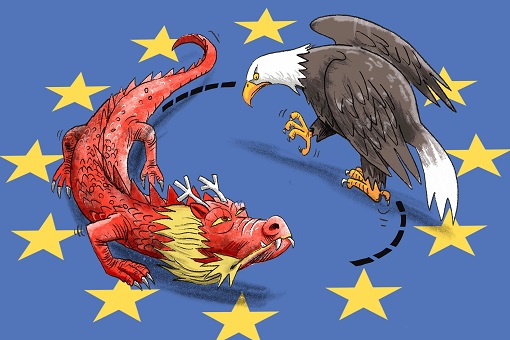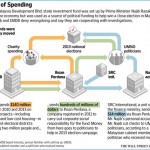When Standard & Poor’s (S&P) lowered America’s AAA credit rating on August 5, 2011 after the 2011 debt ceiling crisis, very few thought it would take another 10 years before Fitch became the second major rating agency to do the same in August 2023 – downgraded United States of America’s Long-Term Foreign-Currency Issuer Default Rating (IDR) to “AA+” from “AAA”.
Last Friday (May 16), the U.S. government lost its last triple-A credit score from a major international ratings firm after a downgrade by Moody’s Investors Service. In lowering the U.S. rating from “AAA” to “AA1”, Moody’s justified that successive U.S. administrations had failed to reverse ballooning deficits and interest costs. In other words, Moody’s has doubts over the U.S.’ ability to pay back its debt.
Moody’s already warned in 2023 that the U.S. triple-A rating was at risk. But the fact that it took only 2 years for the U.S. government trustworthiness to drop again since Fitch Ratings downgraded the U.S. in 2023 and S&P Global Ratings did so in 2011 speaks volumes about the seriousness of American debt problems. Moody’s held a perfect credit rating for the U.S. since 1917, before giving up this month.

With the U.S. losing “top credit rating” from all 3 major credit rating agencies, the world’s largest economy now has a similar credit rating to smaller economies like Austria and Finland. In truth, none of the credit rating agencies are credible or trustworthy. How could Moody’s still maintained a triple-A rating to the U.S. when the country was already burdened with US$33 trillion in 2023, the year Fitch ditched it?
Was there any difference in the U.S. debt between 2023 (US$33 trillion) and today (US$36 trillion) that Moody’s saw the country worth the “AAA” rating in 2023 but not in 2025? In fact, even the White House has questioned Moody’s credibility. White House spokesman Kush Desai said – “If Moody’s had any credibility, they would not have stayed silent as the fiscal disaster of the past four years unfolded.”
The White House accused Moody’s of being biases for not cutting its rating during the previous Biden administration. But the debt did not happen yesterday or began during the era of Joe Biden. The annual deficit of the U.S. federal budget is about US$2 trillion – equivalent to more than 6% of GDP. The U.S. national debt is actually growing by a remarkable US$1 trillion about every 100 days, equal to roughly US$3.6 trillion per year.

Clearly, Moody’s was dragging its feet for as long as possible after S&P and Fitch downgraded the U.S. credit rating for obvious reason. A lower credit rating could lead to worse conditions in the bond market in America because it simply means the U.S. is more likely to default on its sovereign debt, and generally face higher borrowing costs. Even at “AA1”, the rating is a joke as the U.S. is technically bankrupt.
When S&P downgraded the U.S. rating back in 2011, investors fled to the American bond market for safe haven causing the bond yields to drop. However, when Fitch did the same in 2023, the bond yield spiked. This time is no different as investors’ confidence in the bond market plunges, forcing the U.S. Treasury to offer higher yields or returns to attract purchases of its debt notes due to higher risks.
Moody’s latest move saw the 30-year Treasury yield hit a high around 5.03% – levels not seen since November 2023. The 10-year yield initially climbed 2 basis points to reach 4.459%, before hitting 4.558% – its highest level since the 2008 Global Financial Crisis. Meanwhile, the 2-year Treasury yield sheds 1 basis point to 3.972% (one basis is equivalent to 0.01%, and yields and prices move in opposite directions).

Essentially, higher bond yields could affect borrowing costs for companies and consumers who rely on the bond market, which in turn is expected to negatively impact the economy, which depends on the stock market. Thanks to higher bond yields, the “Dollar Index”, which compares the US currency to a basket of global currencies, has fallen by 6.5% since the beginning of the year.
As a rule of thumb, markets consider the 5% yield on US 10-year bonds to be a critical threshold. The bond market is so crucial that In April, when US Treasury yields approached this level, President Donald Trump – despite bragging and tough talks – immediately backed down in his trade war with the rest of the world and suspended tariffs on imports.
It was also not a coincidence that the Moody’s downgrade came on the same day as Trump’s landmark spending bill suffered a setback in Congress. Trump’s so-called “big, beautiful bill” failed to pass the House Budget Committee, with some Republicans voting against it. It didn’t help that the U.S. economy shrank 0.3% in the first three months of 2025 compared to a growth of 2.4% in the previous quarter.

Even though the Moody’s downgrade is largely symbolic as it was the last of the three major rating agencies to cut the U.S. triple-A rating, it does have an impact as international investors have started moving away from the dollar. The Euro alone gained about 8% against the dollar since the beginning of 2025. This also means de-dollarization is gaining steam thanks to Trump’s blunder.
But the debt trouble in the bond market is just the beginning. When Walmart said it had no alternative to raising prices for consumers beginning later this month because it could not absorb the cost of Trump’s tariffs on international trade, the White House was panicked. President Donald Trump said Walmart needs to stop “trying to blame tariffs”, and told the retail giant to “eat the tariffs”.
Trump’s biggest apple polisher, Commerce Secretary Howard Lutnick, immediately parroted his boss with claims that “businesses and the countries primarily eat the tariff.” But Walmart CEO Douglas McMillon said – “We will do our best to keep our prices as low as possible. But given the magnitude of the tariffs, even at the reduced levels announced this week, we aren’t able to absorb all the pressure given the reality of narrow retail margins.”

Walmart, which has over 4,600 stores in the United States, gets merchandise from Canada, China, India, Mexico and Vietnam, among other nations. Trump had initially slapped tariffs as high as 145% on Chinese goods, before chickening out and dropped the rate to 30% as part of a 90-day truce with China. Other countries face baseline tariffs of 10%, whilst negotiating with the U.S. amid a 90-day pause on reciprocal tariffs.
Here’s the hilarious part – if Walmart has to eat the tariffs, as demanded by Mr Trump, then what’s the point of tariffs in the first place? The whole idea of the tariffs, as preached by the president and his team of genius advisers, is to stop Americans buying Chinese products by discouraging them with higher tariffs. In fact, Trump had told all and sundry that China will pay the tariffs and makes America very rich.
If Trump and MAGA supporters still believe Mexico paid for the beautiful wall and China will pay the tariffs, even after the president insisted that Walmart eats the tariffs, then they are stupider than a brick. When the POTUS told Walmart to quietly absorb the tariffs, he was admitting that the tariffs are paid by Americans. Tariff isa tax on people who buy things from foreign businesses.

To date, Americans have paid more than US$242 billion to the U.S. Treasury for tariffs that Trump imposed on imported solar panels, steel and aluminum, and Chinese-made goods, according to the U.S. Customs and Border Protection. While Chinese exporters could lower their selling price to help American importers, the actual tariffs are paid entirely by U.S. importers.
Confronted with warnings of a shortage of toys, Trump told reporters that children should be happy with “two dolls instead of 30 dolls”, and they might “cost a couple bucks more” than usual. If indeed China will have no choice but to eat the U.S. tariffs as repetitively claimed by the U.S. president and Treasury Secretary Scott Bessent, exactly why Trump acknowledged the potential impact tariffs will have on toys?
The simple fact that a war of words has erupted – and still continues – between the U.S. and U.S. retailers over who will pay the tariffs and to what extent should US companies sacrifice their profits to help the US administration reduce its tariff policy’s impacts on US consumers speaks volumes that Trump is under tremendous pressure to justify the rationality of the U.S. tariff policy.

Insider information from American retail chain Target Corporation workers revealed that a US$9.99 USB-C cord is now selling at US$17.99. Additionally, the company also warns that everyday grocery items like strawberries, avocados, bananas and coffee beans will see price increases. Also, as much as 94% of seafood that Americans consume is imported.
Interestingly, fish caught all over the world, including in the U.S., get shipped to China for boning, skinning and filleting, then shipped back to the U.S. for final sale, raising the possibility that the tariffs could be applied twice, which could see prices skyrocket. Walmart is unlikely to listen to Trump, as other companies like Microsoft, Mattel, Ford, Temu and Shein has announced price hikes, which will make debt problems even worse.
Other Articles That May Interest You …
- Art Of War vs. Art Of Deal – China Laughs All The Way To The Bank As Trump Slashes Tariffs From 145% To 30%
- US Economy Shrank 0.3% Thanks To Tariffs – Why “Pissed” Trump Orders Amazon To Hide Tariff Costs
- Empty Store Shelves In 2 Weeks – Here’s Why Trump’s Damage Control Is Too Little Too Late, And It Will Be Ugly
- Trump Chickening Out – To Slash Tariffs On China To 50%-65%, Won’t Fire Fed Chair Powell
- Trump Has Already Lost His Trade War Against China – But He Can’t Find Ways To Climb Down And Save Face
- White House Privately Begging Xi To Call Trump First – But China Slapped 125% Tariff Instead
- Beijing Raises Tariffs To 125% – American Goods No Longer Marketable In China
- Casualty Of Trump Bullying – PM Trudeau Fast Losing His Job After Tariff Threat & Mocking Of Canada As 51st State
- Recession 2025 – Why You Should Prepare For A Historic Crash As Massive Correction Builds
- $6.4 Trillion Wipeout – Financial Meltdown Has Begun As The U.S. Heading Toward A Recession
- From Terminating Trade Deal To Cancelling $1.1 Trillion Debt Owed To China – Here’re Some Of Trump’s Crazy & Dirty Ideas
- Watch Out Trump!! – China May Weaponize “Rare Earth” To Retaliate Against U.S.’ Ban On Huawei

|
|
May 20th, 2025 by financetwitter
|


|

|

|

|

|

|




























Comments
Add your comment now.
Leave a Reply